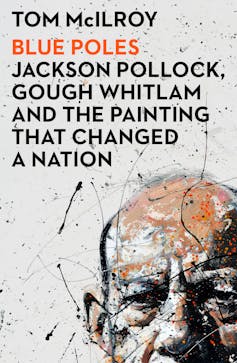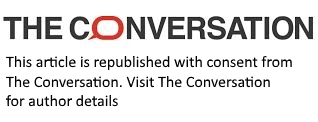Blue Poles and its $1.4m price-tag shocked the nation, but did it change us?
- Written by Joshua Black, Visitor, School of History, Australian National University

Even as a high school student in the 1920s, Jackson Pollock understood the value of art and culture. The young upstart and his friends caused a “classroom scandal” when they published a polemic criticising their school’s “overemphasis on athletics” and “disrespect” of the humanities. They called it the Journal of Liberty, implying that they saw humanities and the arts as essential for realising the American ideal.
Review: Blue Poles: Jackson Pollock, Gough Whitlam and the Painting that Changed Australia – Tom McIlroy (Hachette)
This episode is described early in Blue Poles: Jackson Pollock, Gough Whitlam and the Painting that Changed a Nation, a new book by journalist and first-time author Tom McIlroy. The colourful volume retraces the life and work of the groundbreaking, deeply flawed artist and his distinctive “all-over” style of painting.
It also retells the story of the Australian government’s decision in 1973 to purchase one of the most iconic of Pollock’s works, Blue Poles (1952), in an effort to drag a nation “from adolescence to some kind of cultural maturity”.
These are disparate stories that, when placed in the same frame, show us how much art and culture matter, and how scandalous they can be.
Inner demons and visual depths
Pollock was born in Wyoming in 1912, the youngest of five brothers, all of whom were creatively inclined. His childhood was characterised by movement and disruption, both reflected in his later artistic style.
Pollock was plagued by “inner demons”, as McIlroy puts it, resulting in intense moods, alcoholism, marital disharmony and infidelity. These things mattered, not just in his creative process, but in his relationships. They led to his death, and that of an acquaintance, in an alcohol-fuelled car accident in 1956.
McIlroy demonstrates just how purposeful the acquisition was, in process and in spirit. Whitlam chose to disclose the price, knowing how controversial the record-breaking sum would be. James Mollison, the director of the fledgling national collection whose career was defined by this painting, wasn’t even that fond of Blue Poles. But for both of them, it was worth the political pain because “no work of contemporary art of such importance had ever been offered” to Australia before.
Their bravery has literally paid for itself. Blue Poles was worth US$6,000 when collector Fred Olsen bought it in 1954. He sold it to the art enthusiast Ben Heller three years later for $32,000.
Australia paid Heller AUD$1.4 million for the painting in 1973. Within 25 years, the Museum of Modern Art in New York was offering $25 million for it. Insurers valued it at $350 million in 2016 and $500 million in 2022. Even adjusting for inflation, the later values make the purchase price practically invisible.
The acquisition of Blue Poles sent a powerful signal to Australians that they deserved the best the world had to offer, even if many thought this wasn’t it. It declared that our national identity could be informed by international as well as provincial culture, and that government spending on the arts was not a luxury for the few, but a necessity for society.
Arts today
At the time of its 2016 valuation, senator James Paterson said that Australia should sell Blue Poles and use the proceeds to make a downpayment on public debt. The absurdity of this suggestion was pointed out by Waleed Aly, who observed on The Project that “it would take 1,344 Blue Poles” to eliminate Australia’s debt. Paterson was having none of it: “I don’t think we can afford such a lavish thing as a single painting worth $350 million.”
Paterson’s colleagues quickly discounted this stunt. But it showed that our political debate about arts and cultural policy remained burdened by the cognitive dissonance shown during the Blue Poles affair. We think culture is important, but we rarely agree on what it includes. We think some form of it is a necessity, but when public funds are involved, it can easily be refigured as a luxury.
The COVID-19 pandemic was a golden opportunity for the Australian Government to invest in Australian culture while borrowing costs were low. It could have done what the United States did in the 1930s: use public funds to invest in artists (8.5 million of them, McIlroy notes, among them Jackson Pollock), because it was a public good.
The opportunity was lost. A stimulus package appeared in mid-2020, but much of it was too slow to make a difference. Federal funding for the arts was subsequently cut by 19% in the Morrison Government’s final budget.
The Albanese Government’s Revive cultural policy and its associated funding boost was welcome, but its effects were quickly overshadowed by the ongoing cost-of-living crisis and its impact on artists, institutions and event organisers.
What of arts policy today? Despite the meaningful investment in Revive, budget papers show a planned decline in expenses for “arts and cultural heritage” from $2.14 billion this financial year down to $1.85 billion in 2027-28. This is to make up for a temporary increase of 4.3% in sport and recreation expenses associated with the 2032 Brisbane Olympic Games.
Previous research by the Australia Institute has shown that for every million dollars in turnover, arts and entertainment produces nine jobs. The same turnover in the construction sector produces around one job. By that logic alone, it makes little economic sense to rein in arts spending to pay for what is probably Olympics-related construction.
Tax reform would be another way of creating big improvements with small costs to the national budget. Many artists live on or near the poverty line, but if they are “in business”, their grants and prize income are considered taxable. The National Association for the Visual Arts has called for all arts grants and prizes to be income tax exempt. It hardly makes sense to give with one hand and take back with the other.
The same could be said in relation to Australia’s national cultural institutions, including the National Gallery of Australia and the National Film and Sound Archive. Efficiency dividends imposed on the public service require savings year on year. But unlike big government agencies, these are small institutions with a mission to collect art for the public’s benefit.
When public property and valuable artefacts were endangered by the leaky buildings housing them, the government offered a $535 million lifeline. But wouldn’t it be more logical to exempt these institutions from “efficiency dividends” so that they don’t get so run down to begin with?
Finally, the Commonwealth could make an enormous difference for a small sum with the creation of a youth cultural pass. Something as simple as a $200 voucher for young Australians to attend cultural events would provide a huge boost to the performing arts. A similar scheme for the visual arts would do much to promote engagement with Australia’s world-class art collections.
The Revive cultural policy may have seemed like a declaration of respect for the arts, but there are several things that still need tending to. The ideas outlined above would be targeted, inclusive and unambiguous in the signals they send about the importance of the arts. We have shown disrespect to Australia’s cultural industries for too long.
Authors: Joshua Black, Visitor, School of History, Australian National University





